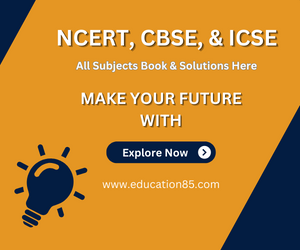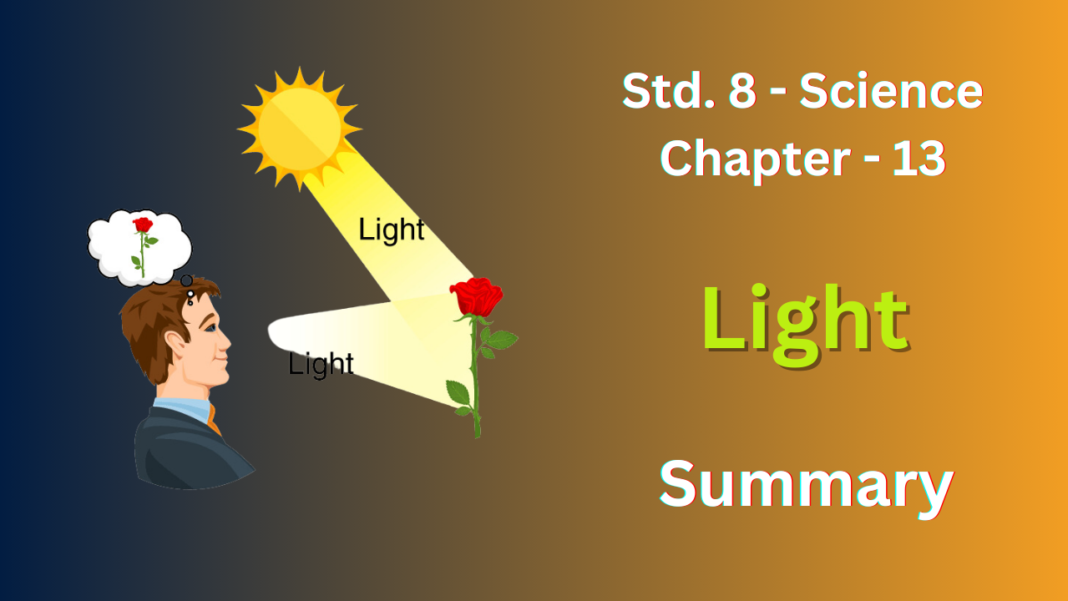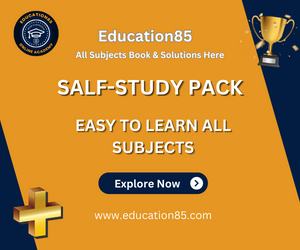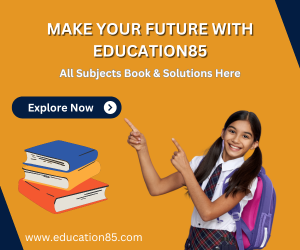NCERT Solutions for Class 8 Science Chapter 13
The chapter in your 8th-grade science book dives into the fascinating world of what allows us to see! Here’s a quick summary:
Light as a source of vision:
- We see things because it bounces off them and enters our eyes.
- Without it, we wouldn’t be able to see anything, even if our eyes were open.
Properties of light:
- It travels in straight lines, which is why we can create shadows.
- It can be reflected when it hits a smooth surface like a mirror. This reflected light allows us to see objects that aren’t directly in our line of sight.
Unveiling the rainbow:
- White light, like sunlight, is actually made up of many colors!
- A prism can bend it and separate it into these colors, which we see as a rainbow.
The wonderful human eye:
- The chapter might also touch upon how our eyes work with it. The eye focuses light and sends signals to our brain, allowing us to perceive what we see.
This is just a basic overview. The chapter likely goes into more detail about these concepts, including experiments and diagrams to help you understand them better.
Q1. Suppose you are in a dark room. Can you see objects in the room? Can you see objects outside the room? Explain.
Ans: No. No light to see objects inside. Might see outside if there is a light source there.
Q2. Differentiate between regular and diffused reflection. Does diffused reflection mean the failure of the laws of reflection?
Ans Regular Reflection:
- Smooth surface (mirror)
- Light reflects at same angle it hits
- Forms a clear image
Diffused Reflection:
- Rough surface (painted wall)
- Light scatters in many directions
- Doesn’t form a clear image
Q3.Mention against each of the following whether regular or diffused reflection will take place when a beam of light strikes. Justify your answer in each case.
Ans:
Polished spoon – Regular: Smooth surface reflects clearly.
Paper – Diffused: Roughness scatters light in all directions.
Lake – Depends: Calm = Regular (reflection), Rippled = Diffused (scattering).
Q4. State the laws of reflection.
Ans: The law of reflection are :-
Incident angle = Reflection angle.
Incident ray, reflected ray, and surface normal all lie in the same plane.
Q5. Describe an activity to show that the incident ray, the reflected ray and the normal at the point of incidence lie in the same plane.
Ans:
1.Shine a light (pencil with eraser) on a mirror (standing on paper).
2.Trace the incident and reflected rays on the paper (without moving mirror).
3.Draw the normal to the mirror at the point of incidence.
4.Observe: Incident ray, reflected ray, and normal all lie on the flat paper = same plane.
Q6.Fill in the blanks in the following.
(a) A person 1 m in front of a plane mirror seems to be ______ m away from his image.
(b) If you touch your ______ ear with a right hand in front of a plane mirror it will be seen in the mirror that your right ear is touched with _____
(c) The size of the pupil becomes _______ when you see in dim light.
(d) Night birds have _______ cones than rods in their eyes.
Ans:
- 2
- left ,left hand
- Larger
- Lesser
Q7. The angle of incidence is equal to the angle of reflection
(a) Always
(b) Sometimes
(c) Under special conditions
(d) Never
Ans: (a) always
Q8. Image formed by a plane mirror is:
(a) virtual, behind the mirror and enlarged.
(b) virtual, behind the mirror and of the same size as the object.
(c) real at the surface of the mirror and enlarged.
(d) real, behind the mirror and of the same size as the object.
Ans: (b) virtual, behind the mirror and of the same size as the object.
Q9.Describe the construction of a kaleidoscope.
Ans: A kaleidoscope is a fun and fascinating tool that creates beautiful, ever-changing patterns using mirrors and colourful objects.
Make a mirror triangle with 3 reflective strips of mirror taped together.
Put colourful objects between clear plastic and cardboard.
Slide mirror triangle into tube, object chamber on one end.
Seal both ends with cardboard circles, one with a hole for viewing.
Light reflects between mirrors, showing ever-changing patterns of your colorful objects.
Q10. Draw a labelled sketch of the human eye.
Ans: Circle with thirds. Front third bulges (cornea). Center black circle (pupil), colored ring around it (iris). Rest light gray. Sclera on outer layer, retina in back, optic nerve line exits bottom.
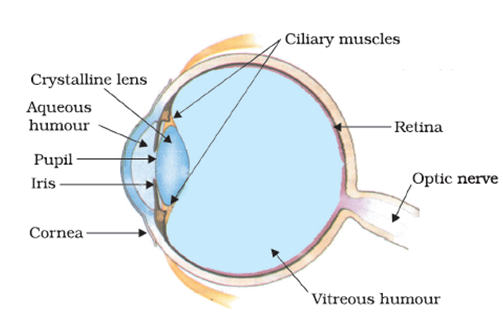
Q11. Gurmit wanted to perform Activity 16.8 using a laser torch. Her teacher advised her not to do so. Can you explain the basis of the teacher’s advice?
Ans: Laser beams are super concentrated light that can damage your eyes, so it’s unsafe for Activity 16.8.
Q12. Explain how you can take care of your eyes.
Ans:
Eat healthy (fruits, veggies, fish).
Protect from sun (UV sunglasses).
Limit screen time (20-20-20 rule).
Don’t smoke.
Regular eye exams.
Good hygiene (wash hands, clean contacts).
Proper lighting.
Enough sleep.
Q13. What is the angle of incidence of a ray if the reflected ray is at an angle of 90° to the incident ray?
Ans: When the reflected ray is at a 90° angle to the incident ray, the angle of incidence is 45 degrees.
This is because the law of reflection states that the angle of incidence (θi) is equal to the angle of reflection (θr). In this case, where the reflected ray is perpendicular to the incident ray, θr = 90°. Therefore, for the law of reflection to hold true, the angle of incidence (θi) must also be 45°.
Q14. How many images of a candle will be formed if it is placed between two parallel plane mirrors separated by 40 cm?
Ans: Infinite images. Reflections bounce back and forth between the mirrors forever, creating countless virtual images.
Q15. Two mirrors meet at right angles. A ray of light is incident on one at an angle of 30° as shown in Fig. 16.19. Draw the reflected ray from the second mirror.
Ans: It reflects at 30 degrees from each mirror due to the law of reflection. Since mirrors are at 90 degrees, the final reflected ray will be parallel to the original incident ray but on the opposite side.
Q16.Boojho stands at A just on the side of a plane mirror as shown in Fig. 16.21. Can he see himself in the mirror? Also, can he see the image of objects situated at P, Q, and R?
Ans: Boojho:
- Himself – No (image behind mirror)
- Object Q – Yes (reflected light reaches eyes)
- Object P – No (reflected light goes upwards)
- Object R – No (reflected light goes downwards)
Q17. (a) Find out the position of the image of an object situated at A in the plane mirror (Fig. 16.23).
(b) Can Paheli at B see this image?
(c) Can Boojho at C see this image?
(d) When Paheli moves from B to C, where does the image of A move?
Ans: (a) Image of A: Behind the mirror, mirror-wise replica at same distance.
(b) Paheli: Yes (reflected light reaches her eyes).
(c) Boojho: No (too far from the reflection point).
(d) Image movement: Doesn’t move. Image location is fixed behind the mirror
FAQ’s
What topics are covered in Class 8 Science Chapter 13?
Class 8 Science Chapter 13 covers various aspects of light, including reflection, refraction, and the properties of light.
How can NCERT Solutions help me understand light better?
NCERT Solutions provide detailed explanations, diagrams, and exercises to help you grasp the concepts of light effectively.
Are there any practical experiments related to light in this chapter?
Yes, Class 8 Science Chapter 13 includes practical experiments that demonstrate the principles of reflection and refraction.
Can I use NCERT Solutions for exam preparation?
Absolutely! NCERT Solutions offer comprehensive coverage of the chapter, making them ideal for exam revision and practice.
Are there any real-life applications of the concepts discussed in this chapter?
Yes, understanding the properties of light is essential in various fields such as optics, photography, and even everyday activities like driving and using mirrors.


